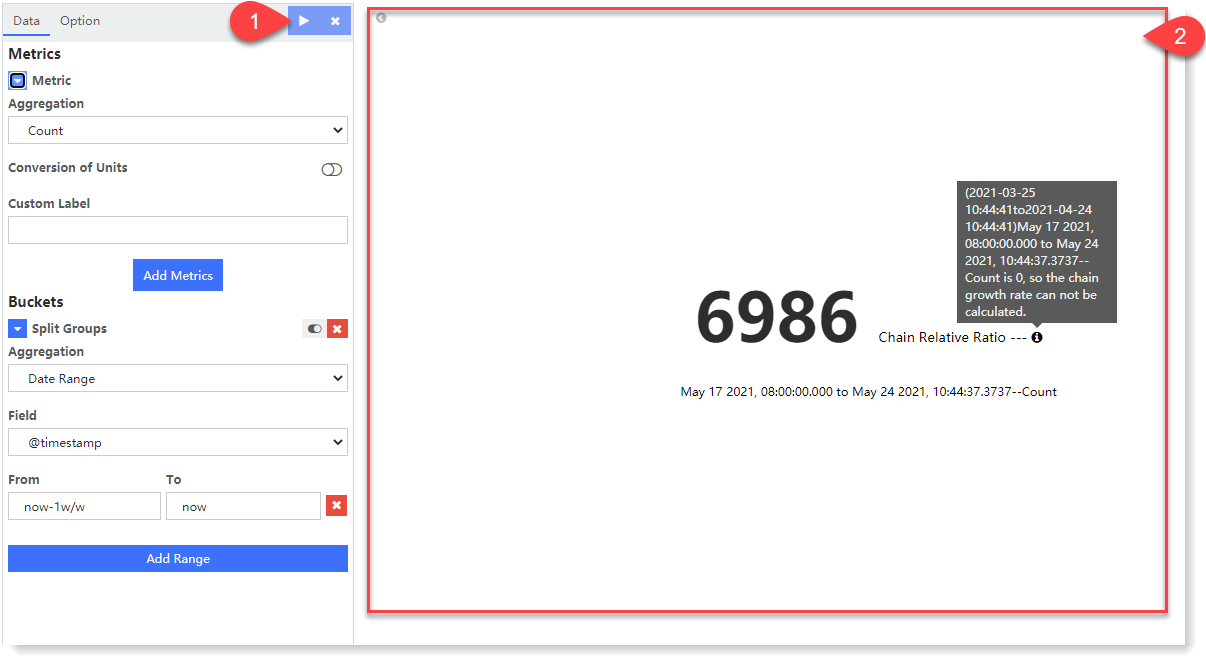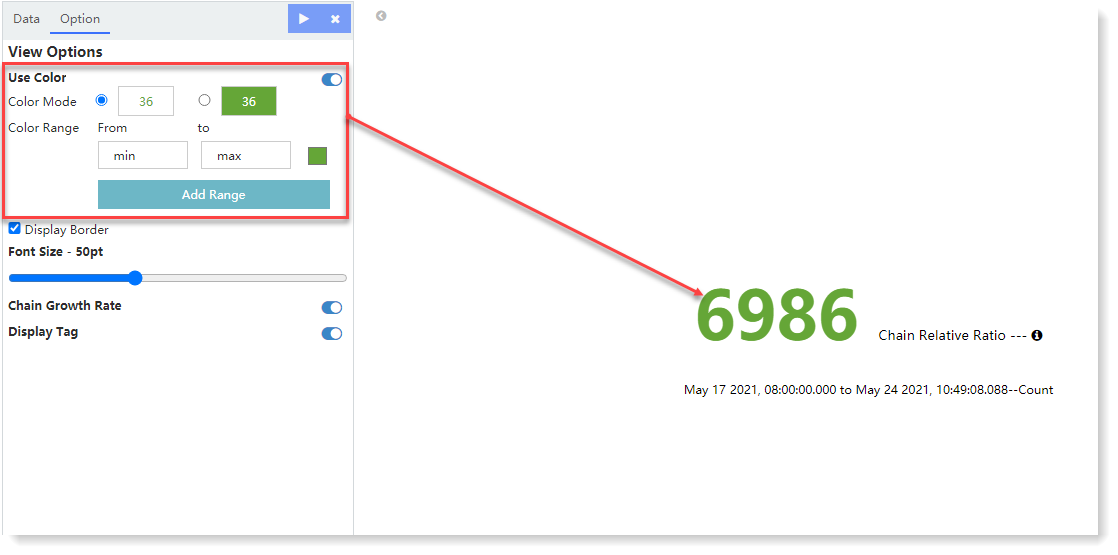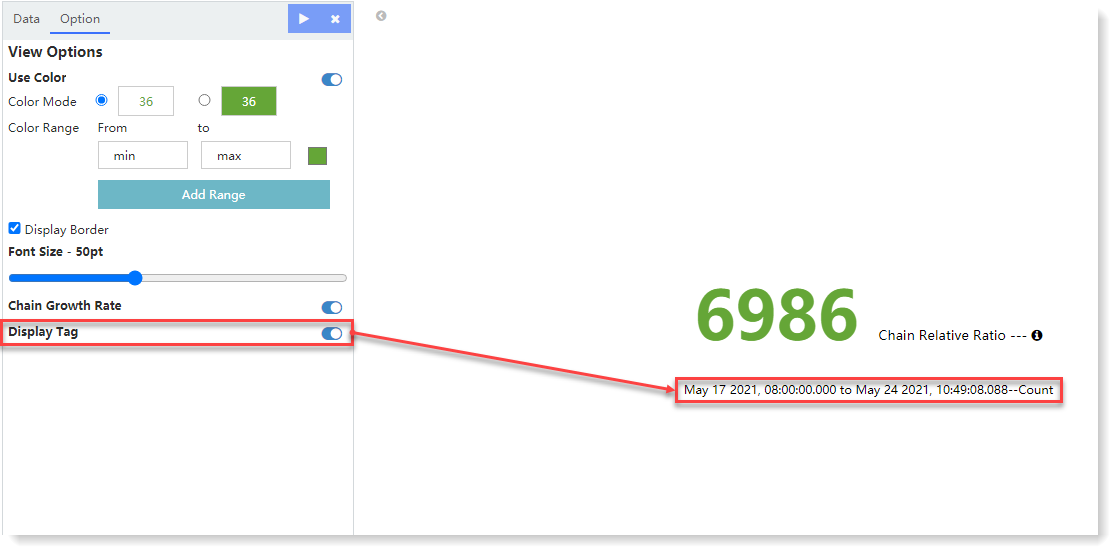Updated at: 2022-12-09 03:49:50
Metric can be used to calculate the original count or unique count of events in the selected time period, and the average, maximum, minimum, standard deviation, sum, median, unique count, percentile, and percentile rank of numeric fields.
1. Click Visualization > Metric to select data sources. You can filter out the required data sources by selecting Log Group or Saved Search;
2. Make Metric visualization editing, and configure parameters as follows:
1) Metrics - Y axis: One or multiple metric aggregation types can be added;
• Aggregation: Select the type of aggregation for the y-axis: Count (default), Avg, Sum, Median, Min, Max, Unique Count, Percentiles, Percentile Ranks, and TopN;
• Conversion of Units: Set the conversion from original units to target units, and you can enable/disable this function;
• Custom Tag: Set the axis name displayed on the Y axis
2) Buckets - X axis: Classify bucket aggregation on field values according to the selected fields:
• Buckets Type: Select Split Group;
• Aggregation: Available types: Date Histogram, Histogram, Range, Date Range, IPv4 Range, Terms, Filters, Significant Terms;
• Field: Set the fields to be aggregated;
• Custom Tag: Set the axis name displayed on the X axis
3. After completing the above configuration, click the button at the top left to check the visual view on the right, as follows:
button at the top left to check the visual view on the right, as follows:

In the above example, the log data count results are classified according to the date range (bucket aggregation type) and @ timestamp (aggregation field). Click the button in the right to view the chain growth rate of the current count value compared with the previous day.
in the right to view the chain growth rate of the current count value compared with the previous day.
4. For the generated chart, you can also switch to Option and set the following parameters:
• Use Color: Disable by default. After enabling, the Color Mode and Color Range can be added, and the Metric aggregation value can be displayed in changed color according to the set data range;

• Chain Growth Rate: Enable by default. After enabling, the chain growth rate can be displayed, which is used to reflect the increase or decrease degree of the current period value compared with the previous period value;
• Display Tag: Enable by default. After enabling, the Metric Custom Tag can be displayed, as follows:

5. After visual view configuration, click Save to complete the current visual view creation.
1. Click Visualization > Metric to select data sources. You can filter out the required data sources by selecting Log Group or Saved Search;
2. Make Metric visualization editing, and configure parameters as follows:
1) Metrics - Y axis: One or multiple metric aggregation types can be added;
• Aggregation: Select the type of aggregation for the y-axis: Count (default), Avg, Sum, Median, Min, Max, Unique Count, Percentiles, Percentile Ranks, and TopN;
• Conversion of Units: Set the conversion from original units to target units, and you can enable/disable this function;
• Custom Tag: Set the axis name displayed on the Y axis
2) Buckets - X axis: Classify bucket aggregation on field values according to the selected fields:
• Buckets Type: Select Split Group;
• Aggregation: Available types: Date Histogram, Histogram, Range, Date Range, IPv4 Range, Terms, Filters, Significant Terms;
• Field: Set the fields to be aggregated;
• Custom Tag: Set the axis name displayed on the X axis
3. After completing the above configuration, click the
 button at the top left to check the visual view on the right, as follows:
button at the top left to check the visual view on the right, as follows: 
In the above example, the log data count results are classified according to the date range (bucket aggregation type) and @ timestamp (aggregation field). Click the button
 in the right to view the chain growth rate of the current count value compared with the previous day.
in the right to view the chain growth rate of the current count value compared with the previous day.4. For the generated chart, you can also switch to Option and set the following parameters:
• Use Color: Disable by default. After enabling, the Color Mode and Color Range can be added, and the Metric aggregation value can be displayed in changed color according to the set data range;

• Chain Growth Rate: Enable by default. After enabling, the chain growth rate can be displayed, which is used to reflect the increase or decrease degree of the current period value compared with the previous period value;
• Display Tag: Enable by default. After enabling, the Metric Custom Tag can be displayed, as follows:

5. After visual view configuration, click Save to complete the current visual view creation.
< Previous:
Next: >

















